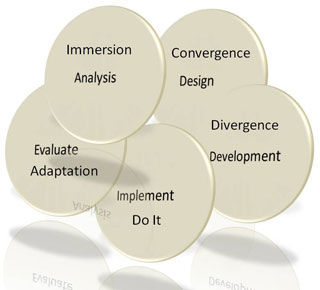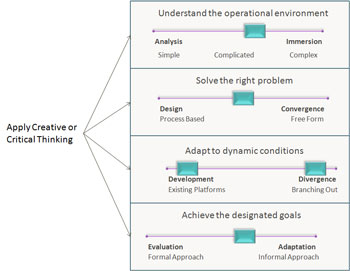This is the sixth post in a series on extending ADDIE in order to solve wicked or complex problems:
- Post 1: Innovating With ADDIE
- Post 2: Analysis and Immersion
- Post 3: Design and Convergence
- Post 4: Development and Divergence
- Post 5: Evaluate and Adaptation

I have been doing a series of posts on Design and how ADDIE relates to Frog Design's Immersion, Convergence, Divergence, and Adaptation (ICDA) when Simon Bostock (@BFchirpy) tweeted about the U.S. Army and Design — Design Thinking Comes to the U.S. Army. And what is quite interesting is their five fundamentals of design as outlined in their Field Manual (pdf):
- Apply critical thinking.
- Understand the operational environment.
- Solve the right problem.
- Adapt to dynamic conditions.
- Achieve the designated goals.
What makes it interesting is just like Frog Design's ICDA and ADDIE complimenting each other, the Army's fundamentals of design also fits nicely in:

Click the image for a larger chart
ADDIE is probably the one basic tool that every Learning Designer needs to know and understand because 1) it is a good tool for getting new Learning Designers up and running, 2) no matter what planning and design tool you use to create your learning platforms, you will probably always fall back on some of the steps within ADDIE, and 3) it keeps teams of designers in the loop. However, like any good craftsperson, ADDIE should not be the ONLY tool within your toolkit.
Which has been one of the problems within the Learning Design profession for some time — while there are plenty of Instructional Design tools that can replace parts of ADDIE, there has been few or no Instructional “System” Design tools that make worthy replacements. Frog Design's Solving for Problem X framework with ICDA and the Army's Design Thinking seem to be viable options for extending ADDIE when you are faced with a wicked or complex problem because rather than being composed of a series of steps, which do not work well when facing such problems; they take more adaptive approaches. Thus rather than being a guide for solving problems, ICDA is a tool for innovating, while the Army's Design Thinking is for more complex and wicked problems than ADDIE is normally called for.
In addition, in some organizations innovation has become the end, rather than the means; which means we can have a surplus of innovation. For example, in our own profession we recently had elearning, blended learning, distributed Learning, informal learning, social media, and social learning enter our radar screens, which we have almost treated as ends rather than means for actually accomplishing goals within the organization. Thus, as Adam Richardson writes in his book, Innovation X, our job when working with the organization is “not so much to help its people come up with new innovations as to filter, prioritize, and refine the ones they already have.” Thus our goal is now just as much innovation effectiveness, rather than trying to create more innovations.
When trying to make our innovations more effective, we have to think systems rather than a course or content. For example, the iPod became a great product not because it was a great piece of hardware, but rather because it was a great solution to managing digital music and recordings such as podcasts. And this has been our problem for some time — rather than thinking of the end goal, which in our case is often performance, we often only think in terms such as courseware or learning.
Extending ADDIE with the lessons of Frog Design and the U.S. Army should be of great help as we move on to more complex problems.
No comments:
Post a Comment